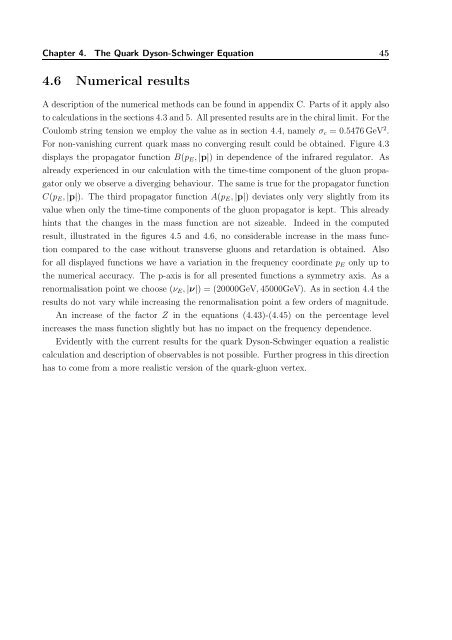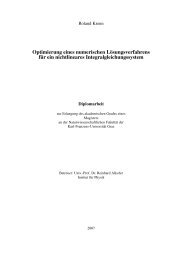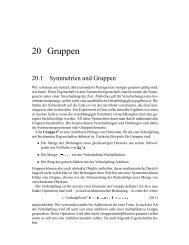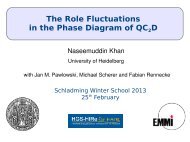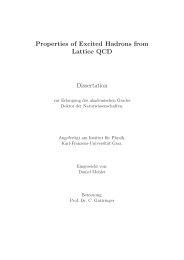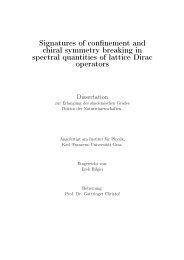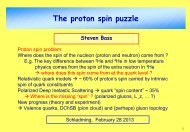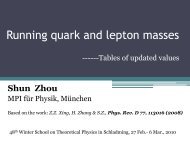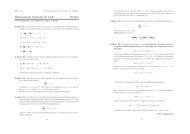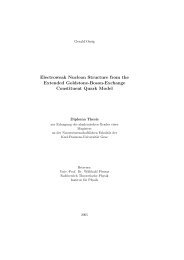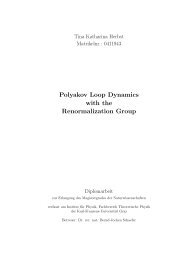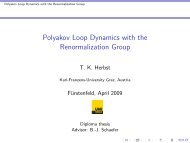The QCD Quark Propagator in Coulomb Gauge and - Institut für Physik
The QCD Quark Propagator in Coulomb Gauge and - Institut für Physik
The QCD Quark Propagator in Coulomb Gauge and - Institut für Physik
You also want an ePaper? Increase the reach of your titles
YUMPU automatically turns print PDFs into web optimized ePapers that Google loves.
Chapter 4. <strong>The</strong> <strong>Quark</strong> Dyson-Schw<strong>in</strong>ger Equation 45<br />
4.6 Numerical results<br />
A description of the numerical methods can be found <strong>in</strong> appendix C. Parts of it apply also<br />
to calculations <strong>in</strong> the sections 4.3 <strong>and</strong> 5. All presented results are <strong>in</strong> the chiral limit. For the<br />
<strong>Coulomb</strong> str<strong>in</strong>g tension we employ the value as <strong>in</strong> section 4.4, namely σ c = 0.5476 GeV 2 .<br />
For non-vanish<strong>in</strong>g current quark mass no converg<strong>in</strong>g result could be obta<strong>in</strong>ed. Figure 4.3<br />
displays the propagator function B(p E , |p|) <strong>in</strong> dependence of the <strong>in</strong>frared regulator. As<br />
already experienced <strong>in</strong> our calculation with the time-time component of the gluon propagator<br />
only we observe a diverg<strong>in</strong>g behaviour. <strong>The</strong> same is true for the propagator function<br />
C(p E , |p|). <strong>The</strong> third propagator function A(p E , |p|) deviates only very slightly from its<br />
value when only the time-time components of the gluon propagator is kept. This already<br />
h<strong>in</strong>ts that the changes <strong>in</strong> the mass function are not sizeable. Indeed <strong>in</strong> the computed<br />
result, illustrated <strong>in</strong> the figures 4.5 <strong>and</strong> 4.6, no considerable <strong>in</strong>crease <strong>in</strong> the mass function<br />
compared to the case without transverse gluons <strong>and</strong> retardation is obta<strong>in</strong>ed. Also<br />
for all displayed functions we have a variation <strong>in</strong> the frequency coord<strong>in</strong>ate p E only up to<br />
the numerical accuracy. <strong>The</strong> p-axis is for all presented functions a symmetry axis. As a<br />
renormalisation po<strong>in</strong>t we choose (ν E , |ν|) = (20000GeV, 45000GeV). As <strong>in</strong> section 4.4 the<br />
results do not vary while <strong>in</strong>creas<strong>in</strong>g the renormalisation po<strong>in</strong>t a few orders of magnitude.<br />
An <strong>in</strong>crease of the factor Z <strong>in</strong> the equations (4.43)-(4.45) on the percentage level<br />
<strong>in</strong>creases the mass function slightly but has no impact on the frequency dependence.<br />
Evidently with the current results for the quark Dyson-Schw<strong>in</strong>ger equation a realistic<br />
calculation <strong>and</strong> description of observables is not possible. Further progress <strong>in</strong> this direction<br />
has to come from a more realistic version of the quark-gluon vertex.


